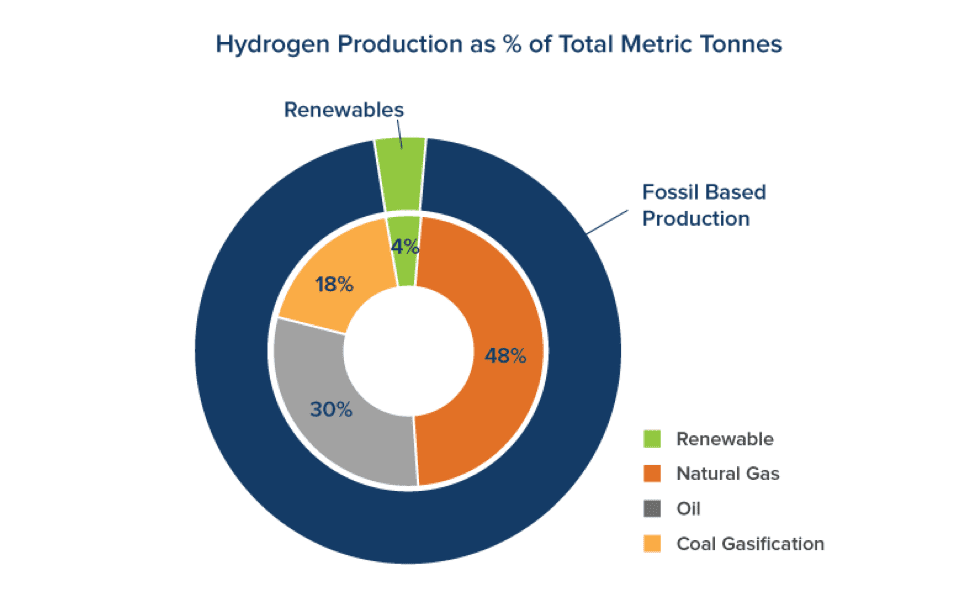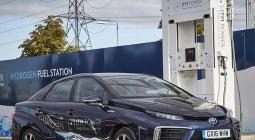The Truth About Hydrogen.
Hydrogen is the new kid on the block of low-carbon alternatives, with applications in mobility, industrial processing, and heavy transport. It can also be used to provide electricity and heat, and can be blended with natural gas to help decarbonize existing natural gas grids. But even with these opportunities, across the globe—from corporate offices to industry roadshows—one hears a frequent refrain: it is too expensive and it won’t scale. (Interestingly enough, this is the same reputation solar PV had a decade ago.)
As misconceptions about hydrogen abound, there is an opportunity to dispel some of the common myths about this emerging technology.
This is not winner-take-all. The energy transition will be a blend of alternative fuels and electrification.
When it comes to technology change, most people think of it as a roulette game where the winner takes all: AC versus DC, QWERTY versus Dvorak, VHS versus Beta. The debate around green options for low-carbon mobility, as well as freight, heavy industry, and materials movement, is no different. The general thinking is that the payoff will come from either electrification or innovative fuels, but not both. This is not an either-or situation. Instead, it’s like being stranded on a desert island and choosing between water or food when the only survivable option is to find both. The ultimate solution for low-carbon transport will most likely be a blend of electricity-based and fuel-based options.
Among the fuel-based options, hydrogen dominates the conversation. As generally happens when you’re popular, the haters are expressing doubt over the development of hydrogen resources, fearing that it competes with electrification and battery technology, but this concern doesn’t reflect reality. While electrification and fuels, like hydrogen, both come with their own set of challenges, they both have important roles to play. When electricity from low-carbon generation is substituted for fossil fuels, we can achieve significant reductions in CO2 emissions. With its zero-carbon potential and the role it can play in increasing demand for renewable energy, hydrogen has an important role in our energy transition and is a key complement to electrification.
Hydrogen is already in high demand and the industry will only continue to grow.
New interest in hydrogen has come from the mobility, freight, shipping, power, and industrial processing sectors as they strive to move toward a decarbonized future. There is, however, a large preexisting demand linked to refining and ammonia production and as a feedstock for industrial chemical processes. The development of the hydrogen market reflects the potential for distributed production and the need for flexibility in our transport mix. For example, hydrogen fuel cell buses typically have a range of approximately 500 km, versus 200 km for electric buses. With this range, hydrogen has both the potential to decarbonize rural transport and to offer a solution for uninterrupted services.
Hydrogen production has increased from around 40 million tons in 2005 to approximately 60 million tons today. In 2017, the global hydrogen production market was estimated at $103 billion and is expected to reach $207 billion by 2026, suggesting a compound annual growth rate of 8.1 percent or a market of approximately 121 million metric tons. Given these growth expectations, the Energy Transition Commission (ETC) suggests that by 2050 the market could be in the region of 425–650 million tons per year.
Whichever direction the hydrogen market develops in the next decade, the mounting pressure on hard-to-abate industrial sectors to align toward a 1.5-degree science-based pathway implies the need to take a hard look at what proportion of industrial emissions relate to the on-site and off-site movement of materials and products. For example, on average, around 60 percent of energy used on an open-pit mine relates to on-site materials movement. Industrial emissions produced on site account for 28 percent of global emissions. An additional 16 percent take place in off-site materials movement, more commonly known as freight transport. If hydrogen is to be part of the solution, there will be far more than the current 60 million tons per year of global demand for this commodity.

Source data from Balat, M. “Potential importance of hydrogen as a future solution to environmental and transportation problems,” International Journal of Hydrogen EnergyVolume 33, Issue 15, August 2008, Pages 4013-4029.
You can make hydrogen without emitting CO2. The solution is electrolysis powered by renewable energy.
There are four major sources for commercial production of hydrogen, three of which require fossil fuels: steam methane reformation (SMR), oxidation, and gasification. The fourth source is electrolysis, which separates water into its constituent elements (hydrogen and oxygen) using electricity. When that electricity is produced through renewable resources you can have zero carbon green hydrogen. This is the only non-fossil fuel means of hydrogen production. The SMR process, which emits CO2, requires substantial heat to chemically separate the hydrogen from the methane molecules. When the emissions of that process are not captured, it is referred to as grey hydrogen. When carbon capture and storage (or carbon capture, utilization, and storage) is attached to a facility, it is referred to as blue hydrogen. In addition to SMR, hydrogen can also be synthesized from oil via partial oxidation, or from coal via gasification.
CO2 emitted as a byproduct of SMR hydrogen production accounts for approximately 6 percent of GHG emissions from petroleum refineries in the United States, and up to 25 percent of the GHG emissions from an individual refinery. By source, hydrogen via natural gas accounts for 48 percent of global production, while oil-based production accounts for approximately 30 percent, and coal accounts for 18 percent. Green hydrogen, produced through the electrolysis process using renewable energy, currently accounts for only 4 percent of global production.
The vast majority of hydrogen production today falls into the category of grey hydrogen, as current production relies on fossil fuels and separates the hydrogen and carbon elements. Carbon capture technologies can reduce the carbon emissions by 71–92 percent but the technology is still in a relatively nascent stage. There are also concerns around the storage space necessary for captured carbon. The current movement is toward scaling green hydrogen development and moving away from SMR-based hydrogen. This transition has the benefit of adding demand for a more rapid renewable energy rollout in some of the better renewable energy regions across the United States.
Hydrogen can help massively decarbonize industrial value chains.
Over the past several years, we have seen a growing focus on the need to support the development of the renewables sector through the sustainable extraction of copper, lithium, aluminum, cobalt, nickel, and other minerals. These are critical minerals in the development of everything from transmission and distribution wiring to solar panels, wind turbines, and battery storage. To entirely decarbonize them requires a focus on extractive activities, the transportation of materials, and mineral processing and purification. Hydrogen can play a dynamic role in this effort in many applications. For example, it can be used to provide a scalable resource to power on-site haul trucks or provide resilient power generation for mine processes, either from fuel cells or through turbines. Hydrogen can also be used as part of the heating process through either combustion or by use of high-heat-emitting fuel cells. In mineral processing, hydrogen can replace coking coal in the steelmaking process to reduce iron ore. It can also run on curtailed renewable energy; building an electrolyzer attached to a renewable generation and battery combination can give you greater capacity to capture peak generation and shift it to peak consumption hours. The conversion of curtailed power into hydrogen at certain times during the day offers the prospect of either using the hydrogen later to provide a callable power resource, or using existing natural gas infrastructure as a means of getting more renewable energy to end users.
This is a menu of options rather than a decisive position as differing market conditions, access, or end users will change the potential solutions that hydrogen can provide in renewable energy development. These additional options help reinforce the need for large-scale renewable rollout and provide an additional strand by which renewables can reach end users.
An Inevitable Truth: This Is Going to Happen
Hard-to-abate industry sectors constitute 40 percent of global greenhouse gas emissions. These sectors need a comprehensive approach to decarbonization and they need it now. They need electrification but they also need clean molecular energy. These are not mutually exclusive efforts but can, when structured correctly, work in coordination to facilitate the rapid change that is called for. The pathway to scaling up green hydrogen will require substantial buildout of our renewable energy resources across the globe and the understanding that there are still battles to be fought to meet these targets.
The ETC’s Mission Possible report, Shell’s Sky Scenario, and the International Energy Association’s below 2 degrees Celsius scenario all show well-developed pathways to decarbonizing the hard-to-abate sectors, and those pathways all require substantial global hydrogen growth. Whether it is in trucking with Nikola’s recent launch, or in industrial process innovations like green aluminum or green steel, there is one thing that nearly all major energy mix studies have shown: we will need more hydrogen in our energy mix to keep global warming below 1.5 degrees.
20 August 2019
ROCKY MOUNTAIN INSTITUTE




